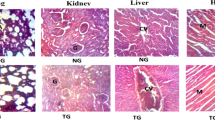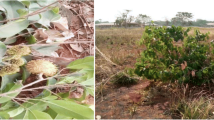Abstract
Acute (24 hours) and chronic (90 days) oral toxicity studies on the ethanolic extracts of common spices Cinnamomum zeylanicum Nees bark and Piper longum L. fruits were carried out in mice. Acute dosages were 0.5, 1.0 and 3 g/kg while the chronic dosage was 100 mg/kg/day. All external morphological, hematological and spermatogenic changes, in addition to body weight and vital organ weights, were recorded. The extracts of both the plants caused no significant acute or chronic mortality compared to the control during this study. During chronic treatment there was no significant change in the pre- and post treatment body weight of the test animals while the weight gain in the control group was significant. C. zeylanicum treatment caused reduction in liver weight while P. longum caused a significant increase in the weight of the lungs and spleen of the treated animals compared to the control. Hematological studies revealed a significant fall in hemoglobin level of C. zeylanicum treated animals. Both of the extracts induced a significant increase in reproductive organ weights, sperm motility, sperm count and failed to illicit any spermatotoxic effect.
Similar content being viewed by others
References
Chopra RN, Nayar SL, Chopra IC (1956) Glossary of Indian Medicinal Plants, Council of Scientific & Industrial Research, New Delhi. p. 66 and 194.
Wagner H, Wolf P (1977) Proceedings of Life Sciences: New Natural Products and Plants Drugs with Pharmacological, Biological or Therapeutical Activity, Springer Verlag, New York.
Abraham SK, Kesavan PC (1985) A preliminary analysis of the genotoxicity of a few spices in Drosophila. Mutation Res 143: 219–223.
Bille N, Larsen JC, Hensen EV, Wurtzen G (1985) Sub-chronic oral toxicity of turmeric oleoresin in pigs. Food Chem Toxicol 23: 967–973.
Kutten R, Bhanumathy P, Nirmala K, George MC (1985) Potential anticancer activity of turmeric (Curcuma longa). Cancer Lett 29: 197–202.
Sengupta S, Ray AB (1987) Chemistry of Piper species: a review. Fitoterapia 3: 147–166.
Evans WC (1989) Trease and Evan's Pharmacognosy, 13th edn, Bailliere Tindall, London. pp. 453–458 and 567–577.
Al-Yahya MA, Rafatullah S, Mossa JS, Ageel AM, Al-Said MS, Tariq M (1990) Gestric antisecretory, antiulcer and cytoprotective properties of ethanolic extract of Alpinia galanga Willd. in rats. Phytotherapy Res 4: 112–114.
Bai YF, Bao YY, Ha S (1993) Study on the antiulcer action of long pepper (Piper longum). Chinese Trad Herb Drugs 24: 639–640.
Said Hk.M (1969) Hamdard Pharmacopoeia of EasternMedicine, Hamdard Foundation, Pakistan. pp. 41–52, 70–83, 107, 272, 276–278 and 287.
Egan H, Kirk RS, Sawyer R (1981) Pearson's Chemical Analysis of Food, 8th edn, Churchill Livingstone, Edinburgh. p. 319.
Tyler VE, Bradly LR, Robber JE (1981) Pharmacognosy, 8th edn, Lea & Febiger, Philadelphia. pp. 121–124.
Shah AH, Qureshi S, Tariq M, Ageel AM (1989) Toxicity studies on six plants used in the Traditional Arab System of Medicine. Phytotherapy Res 3: 25–29.
Tanira MOM, Ageel AM, Tariq M, Mohsin A, Shah AH (1988) Evaluation of some pharmacological, microbiological and physical properties of Zizyphus spina-christi. Int J Crude Drug Res 26: 56–60.
W.H.O. Scientific Group (1967) Principles for Pre-clinical Testing of Drugs Safety, Technical Report Series, World Health Organization. Geneva 341: 9–11.
Wyrobek AJ, Gordon LA, Burkhart JG, Francis MW, Kappa Jr. RR, Letz G, Malling HV, Topham JC, Whorton MD (1983) An evaluation of the mouse sperm morphology test and other sperm tests in non-human mammals. Mutation Res 115: 1–64.
Qureshi S, Ageel AM, Al-Yahya MA, Tariq M, Mossa JS, Shah AH (1990) Preliminary toxicity studies on ethanol extracts of the aerial parts of Artemisia abyssinica and A.inculta in mice. J Ethnopharmacology 28: 157–162.
Wyrobek AJ, Bruce LA (1975) Chemical induction of sperm abnormalities in mice. Proc Nat Acad Sci USA 72: 4425–4429.
Perry LM, Metzger J (1980) Medicinal Plants of Southeast Asia, The MIT Press, Cambridge. p. 198 and 502.
Akira T, Tanaka S, Tabata M (1986) Pharmacological studies on the antiulcergenic activity of Chinese Cinnamon. Planta Med 6: 440–443.
Nohara T, Kashivada Y, Nishioka I (1985) Cinncassiol-E; a diterpene from the bark of Cinnamomum cassia. Phytochemistry 24: 1849–1850.
Vincieri FF, Mazzi G, Mulinacci N, Papini P, Gelsomini N (1988) Monitoring by headspace gas chromatography (HSGC) of essential oils-beta-cyclodextrin inclusion complexation: case of Cinnamomum zeylanicum essential oil. Pharmaceut Acta Helvet 63: 282–286.
Kaleysa RR (1975) Screening of indigenous plants for anthelmintic action against human Ascaris lumbricoides. I. Ind J Physiol Pharmacol 19: 47–79.
Chaurasia SC, Jain PC (1978) Antibacterial activity of four medicinal plants. Ind J Hosp Pharm 15: 166–168.
Ohta T, Watanabe K, Moriya M, Shirasu Y, Kata T (1983) Antimutagenic effects of cinnamaldehyde on chemical mutagenesis on Escherichia coli. Mutation Res 107: 219–227.
Chulasiri MU, Picha P, Rienkijkan M, Preechanukool K (1984) The cytotoxic effect of petroleum ether and chloroform extracts from Ceylon cinnamon (Cinnamomum zeylanicum Nees) bark on tumor cells in vitro. Int J Curde Drug Res 22: 177–180.
Hurlimann AF, Wuthrich B (1995) Eating cinnamon in cinnamaldehyde allergy. Hautarzt 46: 660–661.
Tatrai E, Adamis Z, Ungvary G (1995) The pulmonary toxicity of cinnamon dust in rats. Ind J Med Res 102: 287–292.
Qureshi S, Shah AH, Tariq M, Ageel AM (1989) Studies on herbal aphrodisiacs used in Arab System of Medicine. Am J Chinese Med 16: 57–62.
Bedi KL, Atal CK, Achaya KT (1971) Studies on Indian seed oils. VIII. Component fatty acids of some seed fats of Piperaceae. Lloydia 34: 256–257.
Shoji N, Umeyama A, Saito N, Takemoto T, Kajiwara A, Ohizumi Y (1986) Dehydropipernonaline, an amide possessing coronary vasorelaxant activity was isolated from Piper longum L. J Pharmaceut Sci 75: 1188–1189.
Reddy MK, Chari N, Kokate CK, Sathaiah G (1984) Mitodepressive and clastogenic activity of crude drug combinations on somatic cells of Foeniculum vulagre Mill. Eastern Pharmacist 27: 125–127.
Koul IB, Kapil A (1993) Evaluation of the liver protetive potential of piperine, an active principle of black and long peppers. Planta Med 59: 413–417.
Munshi SR, Shetye TA, Nair RK (1977) Antifirtility activity of three indigenous plant preparations. Planta Med 31: 73–75.
Ageel AM, Mossa JS, Tariq M, Al-Yahya MA, Al-Said MS (1987) Plants used in Saudi Folk Medicine, King Saud University Press, KACST, Riyadh, p. 106.
Ghoshal S, Prasad BN, Lakshmi V (1996) Antimoebic activity of Piper longum fruits against Entamoeba histolytica in vitro and in vivo. J Ethnopharmacology 50: 167–170.
Author information
Authors and Affiliations
Rights and permissions
About this article
Cite this article
Shah, A., Al-Shareef, A., Ageel, A. et al. Toxicity studies in mice of common spices, Cinnamomum zeylanicum bark and Piper longum fruits. Plant Foods Hum Nutr 52, 231–239 (1998). https://doi.org/10.1023/A:1008088323164
Issue Date:
DOI: https://doi.org/10.1023/A:1008088323164




